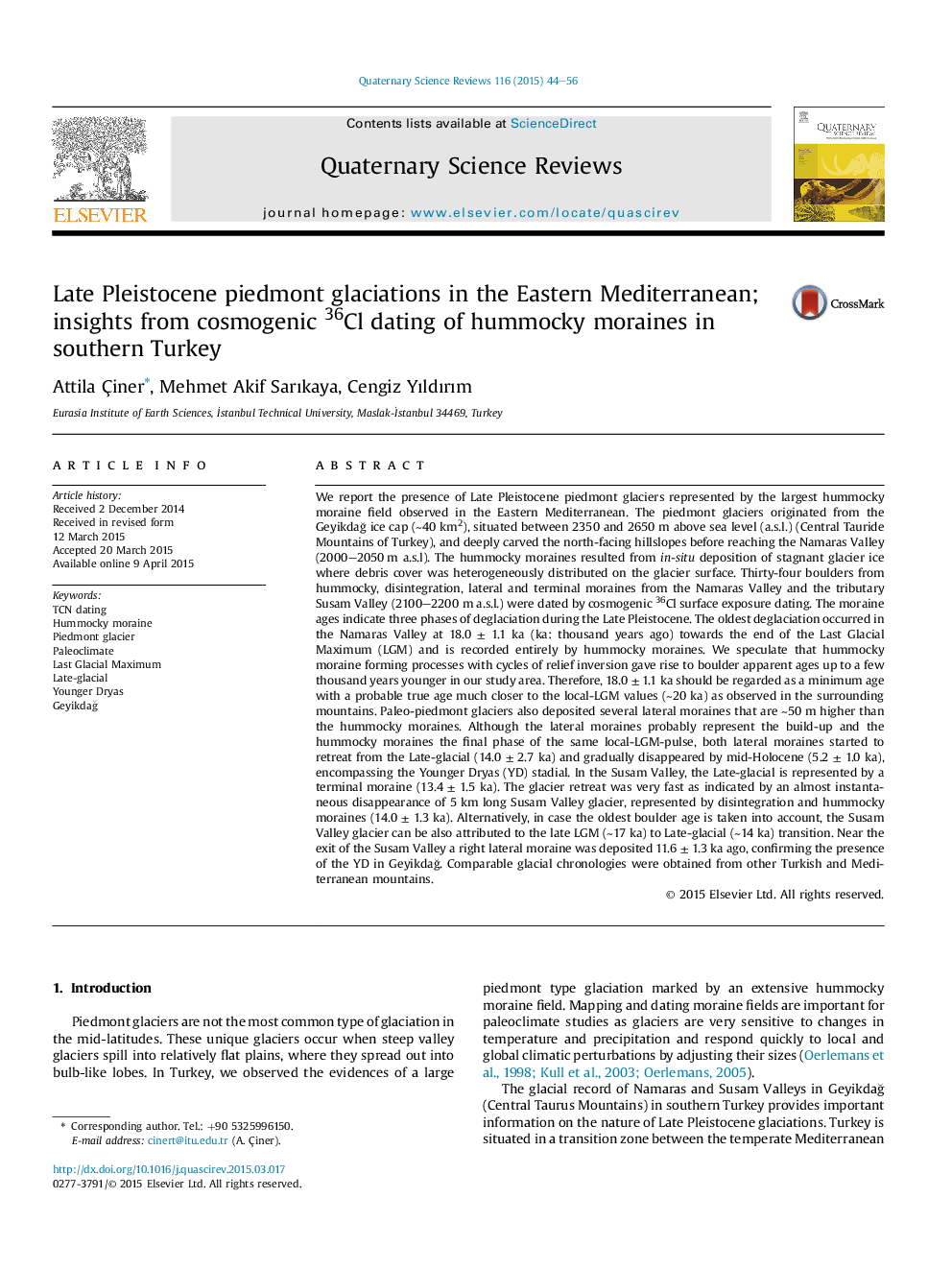| کد مقاله | کد نشریه | سال انتشار | مقاله انگلیسی | نسخه تمام متن |
|---|---|---|---|---|
| 4735307 | 1640818 | 2015 | 13 صفحه PDF | دانلود رایگان |

• Mid-latitude piedmont glaciers deposited hummocky moraines in Taurus Mountains.
• Thirty-four samples were dated by cosmogenic 36Cl nuclides.
• Hummocky moraines settled by 18.0 ± 1.1 ka ago from stagnant glacier ice.
• Lateglacial moraines were deposited between 17.6 ± 2.9 ka and 14.0 ± 2.7 ka ago.
• A Younger Dryas lateral moraine was dated to 11.6 ± 1.3 ka in Susam Valley.
We report the presence of Late Pleistocene piedmont glaciers represented by the largest hummocky moraine field observed in the Eastern Mediterranean. The piedmont glaciers originated from the Geyikdağ ice cap (∼40 km2), situated between 2350 and 2650 m above sea level (a.s.l.) (Central Tauride Mountains of Turkey), and deeply carved the north-facing hillslopes before reaching the Namaras Valley (2000–2050 m a.s.l). The hummocky moraines resulted from in-situ deposition of stagnant glacier ice where debris cover was heterogeneously distributed on the glacier surface. Thirty-four boulders from hummocky, disintegration, lateral and terminal moraines from the Namaras Valley and the tributary Susam Valley (2100–2200 m a.s.l.) were dated by cosmogenic 36Cl surface exposure dating. The moraine ages indicate three phases of deglaciation during the Late Pleistocene. The oldest deglaciation occurred in the Namaras Valley at 18.0 ± 1.1 ka (ka: thousand years ago) towards the end of the Last Glacial Maximum (LGM) and is recorded entirely by hummocky moraines. We speculate that hummocky moraine forming processes with cycles of relief inversion gave rise to boulder apparent ages up to a few thousand years younger in our study area. Therefore, 18.0 ± 1.1 ka should be regarded as a minimum age with a probable true age much closer to the local-LGM values (∼20 ka) as observed in the surrounding mountains. Paleo-piedmont glaciers also deposited several lateral moraines that are ∼50 m higher than the hummocky moraines. Although the lateral moraines probably represent the build-up and the hummocky moraines the final phase of the same local-LGM-pulse, both lateral moraines started to retreat from the Late-glacial (14.0 ± 2.7 ka) and gradually disappeared by mid-Holocene (5.2 ± 1.0 ka), encompassing the Younger Dryas (YD) stadial. In the Susam Valley, the Late-glacial is represented by a terminal moraine (13.4 ± 1.5 ka). The glacier retreat was very fast as indicated by an almost instantaneous disappearance of 5 km long Susam Valley glacier, represented by disintegration and hummocky moraines (14.0 ± 1.3 ka). Alternatively, in case the oldest boulder age is taken into account, the Susam Valley glacier can be also attributed to the late LGM (∼17 ka) to Late-glacial (∼14 ka) transition. Near the exit of the Susam Valley a right lateral moraine was deposited 11.6 ± 1.3 ka ago, confirming the presence of the YD in Geyikdağ. Comparable glacial chronologies were obtained from other Turkish and Mediterranean mountains.
Journal: Quaternary Science Reviews - Volume 116, 15 May 2015, Pages 44–56